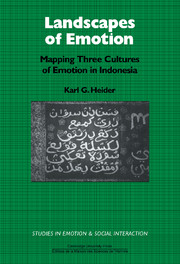Book contents
- Frontmatter
- Contents
- Acknowledgement
- PART I THEORY, METHOD, AND RESULTS
- 1 Theoretical introduction
- 2 Mapping the realm of emotion
- 3 Membership in the realm of emotion: prototypicality
- 4 Emotion scenarios: antecedents and outcomes
- 5 Comparisons between languages
- 6 The composite maps of emotion terms, cluster by cluster
- 7 Conclusions
- PART II A CLUSTER-BY-CLUSTER ANALYSIS OF THE COMPOSITE MAPS OF EMOTION TERMS
- Bibliography
- Author index
- Subject index
4 - Emotion scenarios: antecedents and outcomes
Published online by Cambridge University Press: 22 October 2009
- Frontmatter
- Contents
- Acknowledgement
- PART I THEORY, METHOD, AND RESULTS
- 1 Theoretical introduction
- 2 Mapping the realm of emotion
- 3 Membership in the realm of emotion: prototypicality
- 4 Emotion scenarios: antecedents and outcomes
- 5 Comparisons between languages
- 6 The composite maps of emotion terms, cluster by cluster
- 7 Conclusions
- PART II A CLUSTER-BY-CLUSTER ANALYSIS OF THE COMPOSITE MAPS OF EMOTION TERMS
- Bibliography
- Author index
- Subject index
Summary
The first and most obvious way in which culture may affect the emotions is by determining what situations will give rise to them. Depending upon its cultural context, the same external occurrence may arouse diametrically opposite responses in two different societies.
Otto Klineberg 1935:278Eventually we circle back to the problem of translation: How are we to understand these Minangkabau and Indonesian words through English? We have already stated the assumption that single-word translations are, a priori, suspect. In fact, there are some translation equivalents that may turn out to be quite satisfactory: “anger” and marah, for example, match very well. In other parts of the emotion realm the correspondence is less good: cinta is close to “love,” but it implies more of pity and sadness, less of happiness, than does the English word.
The most economical solution would be to compare unabridged dictionary definitions for closest-fit words in two languages. This move would be based on the (ironic) assumption that although a one-word translation is likely to be off, lots of these inaccurate words will describe a lexical concept better.
Here we can draw on several rich sources. For English, we have the definitive Oxford English Dictionary and the study by Joel R. Davitz, “The Language of Emotion” (1969). (Davitz used a checklist of 556 possible statements about emotions. Fifty American subjects selected the appropriate items on the checklist for each of fifty common emotion words.
- Type
- Chapter
- Information
- Landscapes of EmotionMapping Three Cultures of Emotion in Indonesia, pp. 52 - 58Publisher: Cambridge University PressPrint publication year: 1991



